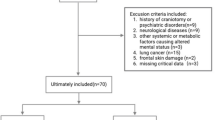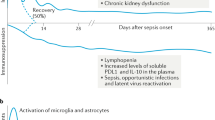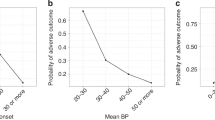Abstract
Background and Objectives
Sepsis leads to systemic inflammatory response with cerebral blood flow (CBF) alteration and blood–brain barrier disruption that contribute to sepsis-associated encephalopathy (SAE). We aimed to evaluate cord blood neuron-specific enolase (cNSE) and CBF in early-onset neonatal sepsis (EONS) as predictors of SAE and to define short-term neurodevelopmental outcomes among survivors.
Methods
cNSE was measured in 200 neonates with antenatal risk factors for EONS, stratified into two groups: sepsis (n = 96) and no-sepsis (n = 104). Trans-cranial Doppler of peak systolic velocities (PSV), end diastolic velocities (EDV) and resistive indices (RI) of anterior (ACA) and middle (MCA) cerebral arteries recorded on day 1 postnatal. Griffiths mental developmental scale (GMDS) was assessed at 6 months.
Results
Increased cNSE, PSV, EDV, and decreased RI of both ACA and MCA were found in sepsis group compared to no-sepsis group (p < 0.001 for all). Patients with SAE (n = 34) had higher NSE, PSV, and EDV as well as lower RI of ACA and MCA compared to those without (p < 0.01 for all). SAE neonates had lower GMDS than those without. ACA RI of ≤0.61 was the best predictor of SAE.
Conclusion
High CBF and cNSE could be useful markers for prediction of SAE. SAE impairs neurodevelopmental scales at 6 months.
Similar content being viewed by others
Log in or create a free account to read this content
Gain free access to this article, as well as selected content from this journal and more on nature.com
or
References
Camacho-Gonzalez, A., Spearman, P. W. & Stoll, B. J. Neonatal infectious diseases: evaluation of neonatal sepsis. Pediatr. Clin. North Am. 60, 367–389 (2013).
Ferreira, R. C., Mello, R. R. & Silva, K. S. Neonatal sepsis as a risk factor for neurodevelopmental changes in preterm infants with very low birth weight. J. Pediatr. 90, 293–299 (2014).
Gullo, A., Bianco, N. & Berlot, G. Management of severe sepsis and septic shock: challenges and recommendations. Crit. Care Clin. 22, 489–501 (2006).
Chaudhry, N. & Duggal, A. K. Sepsis associated encephalopathy. Adv. Med. 2014, 762320 (2014).
Cretin, B., Collongues, N., Philippi, N. & Blanc, F. Sepsis associated encephalopathy. Rev. Neurol. 167, 195–204 (2011).
Wilson, J. X. & Young, G. B. Progress in clinical neurosciences: sepsis-associated encephalopathy: evolving concepts. Can. J. Neurol. Sci. 30, 98–105 (2003).
Zampieri, F. G., Park, M., Machado, F. S. & Azevedo, L. C. Sepsis-associated encephalopathy: not just delirium. Clinics 66, 1825–1831 (2011).
Pytel, P. & Alexander, J. J. Pathogenesis of septic encephalopathy. Curr. Opin. Neurol. 22, 283–287 (2009).
Semmler, A. et al. Sepsis causes neuroinflammation and concomitant decrease of cerebral metabolism. J. Neuroinflamm. 5, 38 (2008).
Hsu, A. A. et al. Neurological injury markers in children with septic shock. Pediatr. Crit. Care. Med. 9, 245–251 (2008).
Snyder, M., Crawford, P., Jamieson, B. & Neher, J. O. What treatment approach to intrapartum maternal fever has the best fetal outcomes? J. Fam. Pract. 56, 401–402 (2007).
Tita, A. T. N. & Andrews, W. W. Diagnosis and management of clinical chorioamnionitis. Clin. Perinatol. 37, 339 (2010).
Newton, E. R. Chorioamnionitis and intraamniotic infection. Clin. Obstet. Gynecol. 36, 795–808 (1993).
Chiesa, C., Panero, A., Osborn, J. F., Simonetti, A. F. & Pacifico, L. Diagnosis of neonatal sepsis: a clinical and laboratory challenge. Clin. Chem. 50, 279–287 (2004).
Rodwell, R. L., Leslie, A. L. & Tudehope, D. I. Early diagnosis of neonatal sepsis using a hematologic scoring system. J. Pediatr. 112, 761–767 (1988).
Tollner, U. Early diagnosis of septicemia in the newborn—clinical-studies and sepsis score. Eur. J. Pediatr. 138, 331–337 (1982).
Ballard, J. L. et al. New ballard score, expanded to include extremely premature-infants. J. Pediatr. 119, 417–423 (1991).
Goldsmith, J. P. & Papile, L.-A. Updated monograph outlines advances in diagnosis, pathophysiology, treatment of neonatal encephalopathy. AAP News 35, 18 (2015).
Griffiths, R. Griffiths Mental Development Scales—Revised: Birth to 2 years (GMDS 0-2) (University of London Press, London, 1954).
Couture, A., Veyrac, C., Baud, C., Saguintaah, M. & Ferran, J. L. Advanced cranial ultrasound: transfontanellar Doppler imaging in neonates. Eur. Radiol. 11, 2399–2410 (2001).
Allison, J. W. et al. Intracranial resistive index (RI) values in normal term infants during the first day of life. Pediatr. Radiol. 30, 618–620 (2000).
Singer, M. et al. The third international consensus definitions for sepsis and septic shock (sepsis-3). JAMA 315, 801–810 (2016).
Basu, S., Dewangan, S., Shukla, R. C., Anupurva, S. & Kumar, A. Cerebral blood flow velocity in early-onset neonatal sepsis and its clinical significance. Eur. J. Pediatr. 171, 901–909 (2012).
Krajcinovic, S. S., Doronjski, A., Barisic, N. & Stojanovic, V. Risk factors for neonatal sepsis and method for reduction of blood culture contamination. Malawi Med. J. 27, 20–24 (2015).
Wynn, J. L. & Levy, O. Role of innate host defenses in susceptibility to early-onset neonatal sepsis. Clin. Perinatol. 37, 307–337 (2010).
Bizzarro, M. J., Raskind, C., Baltimore, R. S. & Gallagher, P. G. Seventy-five years of neonatal sepsis at Yale: 1928-2003. Pediatrics 116, 595–602 (2005).
Bourchier, D. & Weston, P. J. Randomised trial of dopamine compared with hydrocortisone for the treatment of hypotensive very low birthweight infants. Arch. Dis. Child. Fetal Neonatal Ed. 76, F174–F178 (1997).
Shehab El-Din, E. M., El-Sokkary, M. M., Bassiouny, M. R. & Hassan, R. Epidemiology of neonatal sepsis and implicated pathogens: a study from Egypt. Biomed. Res. Int. 2015, 509484 (2015).
Meremikwu, M. M., Nwachukwu, C. E., Asuquo, A. E., Okebe, J. U. & Utsalo, S. J. Bacterial isolates from blood cultures of children with suspected septicaemia in Calabar, Nigeria. BMC Infect. Dis. 5, 110 (2005).
MacKenzie, E. T., McCulloch, J., O’Kean, M., Pickard, J. D. & Harper, A. M. Cerebral circulation and norepinephrine: relevance of the blood–brain barrier. Am. J. Physiol. 231, 483–488 (1976).
Vincent, J. L. Microvascular endothelial dysfunction: a renewed appreciation of sepsis pathophysiology. Crit. Care 5, S1–S5 (2001).
Yao, B., Zhang, L. N., Ai, Y. H., Liu, Z. Y. & Huang, L. Serum S100beta is a better biomarker than neuron-specific enolase for sepsis-associated encephalopathy and determining its prognosis: a prospective and observational study. Neurochem. Res. 39, 1263–1269 (2014).
Zenaide, P. V. & Gusmao-Flores, D. Biomarkers in septic encephalopathy: a systematic review of clinical studies. Rev. Bras. Ter. Intensiv. 25, 56–62 (2013).
Dammann, O., Kuban, K. C. & Leviton, A. Perinatal infection, fetal inflammatory response, white matter damage, and cognitive limitations in children born preterm. Ment. Retard. Dev. Disabil. Res. Rev. 8, 46–50 (2002).
Kiechl-Kohlendorfer, U., Ralser, E., Pupp Peglow, U., Reiter, G. & Trawoger, R. Adverse neurodevelopmental outcome in preterm infants: risk factor profiles for different gestational ages. Acta Paediatr. 98, 792–796 (2009).
Ramirez, M. Multiple organ dysfunction syndrome. Curr. Probl. Pediatr. Adolesc. Health Care 43, 273–277 (2013).
Harrois, A., Huet, O. & Duranteau, J. Alterations of mitochondrial function in sepsis and critical illness. Curr. Opin. Anaesthesiol. 22, 143–149 (2009).
Short, M. A. Linking the sepsis triad of inflammation, coagulation, and suppressed fibrinolysis to infants. Adv. Neonatal Care. 4, 258–273 (2004).
Rocha, G., Proenca, E., Quintas, C., Rodrigues, T. & Guimaraes, H. Chorioamnionitis and brain damage in the preterm newborn. J. Matern. Fetal Neonatal Med. 20, 745–749 (2007).
Hornik, C. P. et al. Early and late onset sepsis in very-low-birth-weight infants from a large group of neonatal intensive care units. Early Hum. Dev. 88(Suppl 2), S69–S74 (2012).
Author information
Authors and Affiliations
Contributions
M.S.E.S. and R.A.E.F. conceptualized and designed the study. N.M.E.R. and H.A.S. contributed to the conceptualization and drafted the initial manuscript. H.E.M. and D.H.S. contributed to the study design and performed Doppler ultrasonography. M.A.A.S. and N.M.B. supervised data collection, laboratory investigations, and analyzed and interpreted the data. A.S.F. contributed to the study design, selection of obstetric patients and diagnosis of maternal chorioamnionitis, and analyzed and interpreted the data. A.K.E.Z. contributed to the conceptualization, performed Griffiths mental developmental scale, and neurological examination at 6 months of age. All authors contributed to data interpretation and manuscript writing and have read and approved the final submission.
Corresponding author
Ethics declarations
Competing interests
The authors declare no competing interests.
Additional information
Publisher's note: Springer Nature remains neutral with regard to jurisdictional claims in published maps and institutional affiliations.
Electronic supplementary material
Rights and permissions
About this article
Cite this article
El Shimy, M.S., El-Raggal, N.M., El-Farrash, R.A. et al. Cerebral blood flow and serum neuron-specific enolase in early-onset neonatal sepsis. Pediatr Res 84, 261–266 (2018). https://doi.org/10.1038/s41390-018-0062-4
Received:
Revised:
Accepted:
Published:
Issue date:
DOI: https://doi.org/10.1038/s41390-018-0062-4
This article is cited by
-
Clinical Applications of Point-of-Care and Diagnostic Transcranial Doppler in the Pediatric Acute Care Setting: A Scoping Review
Neurocritical Care (2025)
-
Multifunctional roles of γ-enolase in the central nervous system: more than a neuronal marker
Cell & Bioscience (2024)
-
Ginsenoside Rh2 Alleviate Sepsis-related Encephalopathy via Up-regulating Nrf2/HO-1 Pathway and Apoptosis Inhibition
Cell Biochemistry and Biophysics (2024)
-
Paediatric sepsis-associated encephalopathy (SAE): a comprehensive review
Molecular Medicine (2023)
-
Clinical features, electroencephalogram, and biomarkers in pediatric sepsis-associated encephalopathy
Scientific Reports (2022)



